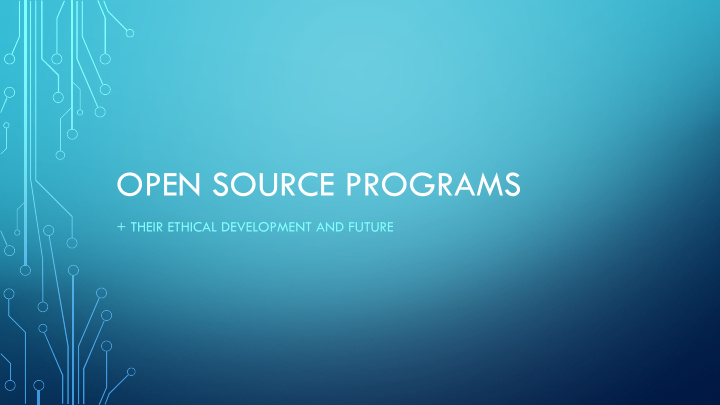



OPEN SOURCE PROGRAMS + THEIR ETHICAL DEVELOPMENT AND FUTURE
OPEN SOURCE PROGRAMS PROVIDE A VIABLE FOUNDATION FOR THE SUSTAINABLE FUTURE OF THE WORLD ’S CREATIVE ECONOMY. FIGURE A Figure A. Skok, 2012, p. 13
WHAT IS AN OPEN SOURCE PROGRAM? A Program is… A set of instructions In human-comprehendible language Converted into computer-digestible language Executed on computers by humans Open Source is… Providing access to human-comprehendible instructions Allowing modification and redistribution of “source code”
WHAT ARE THE ISSUES? Lack of Creativity Economy based on creative design 1 … Requires motivations (both now and later) 2 Lack of Attribution Widespread use of collaborative code… Requires motivations (both intrinsic and extrinsic) 3 1. Florida, 2002, p. 15; 2. Florida, 2002, p. 23; 3. Lakhani and Wolf, 2003, p. 5-6
WHY SHOULD I CARE? Amount of Linux Systems Reasons for Use 3500 Currently In-Use by Kernel Created for select user needs/interests 4 3000 Version Provides reciprocal developer communities 5 2500 2000 1500 Ubiquity of Use 1000 Deployed in large majority of web platforms 500 Provides 80% of internet mail services 6 0 2.0.28 2.0.33 2.0.34C52_SK 2.0.37 2.2.10 2.2.13 2.2.15 2.2.17 2.2.18pre21 2.2.19ext3 2.2.20 2.2.21 2.2.23 2.2.25 2.4.0 2.4.12 2.4.14 2.4.17 2.4.19 2.4.20 2.4.21 2.4.4 2.4.6 2.4.8 2.4.x 2.5.65 2.5.67 2.5.69 2 2.4 Others Total: 7073 Systems FIGURE B 4. Bonaccorsi and Rossi, 2003, p. 1245; 5. Lakhani and Wolf, 2003, p. 7; 6. Krishnamurthy, 2003, p. 2 Figure B. Data from Krishnamurthy, 2003, p. 12-13
WHAT ARE THE SOLUTIONS? ENCOURAGING CREATIVITY ENFORCING ATTRIBUTION • Create communities that allow free • Use General Public Licensing (GNU GPL) contributions 7 • Open code to free viewing and modification • Open code to developers of multiple skillsets • Make code accessible to users and • Allow for each programmer to work on their developers creative specialization. • Ensure all development is properly attributed 9 • Provide environment needed for a content workforce 8 7. Lakhani and Wolf, 2003, p. 4 ; 8. Florida, 2002, p. 26; 9. Lakhani and Wolf, 2003, p. 5-6
NOW WHAT? If Users adopt Open Source Software… Consumers will develop sustainable consumption habits Developers will continually create new solutions 10 In this possible future… Users can access, share, download, and create content Protected by a general public license 10. Bonaccorsi and Rossi, 2003, p. 1245
REFERENCES Bonaccorsi, A., & Rossi, C. (2003). Why open source software can succeed. Research Policy , 32(7), 1243-1258. doi:http://dx.doi.org.offcampus.lib.washington.edu/10.1016/S0048-7333(03)00051-9 Krishnamurthy, S. (2005). An analysis of open source business models. Perspectives on free and open source software , 279-296. Florida, R. L. (2002). The rise of the creative class: And how it's transforming work, leisure, community and everyday life . New York, NY: Basic Books. Lakhani, K., & Wolf, R. (2003). Why hackers do what they do: Understanding motivation and effort in Free/Open source software projects. MIT Sloan Working Paper no. 4425-03, (September) Skok, Michael J (May 19, 2012). 2012 Future of Open Source - 6th Annual Survey results. Northbridge and Black Duck Software . http://www.slideshare.net/mjskok/2012-future-of-open-source-6th-annual-survey-results
Recommend
More recommend